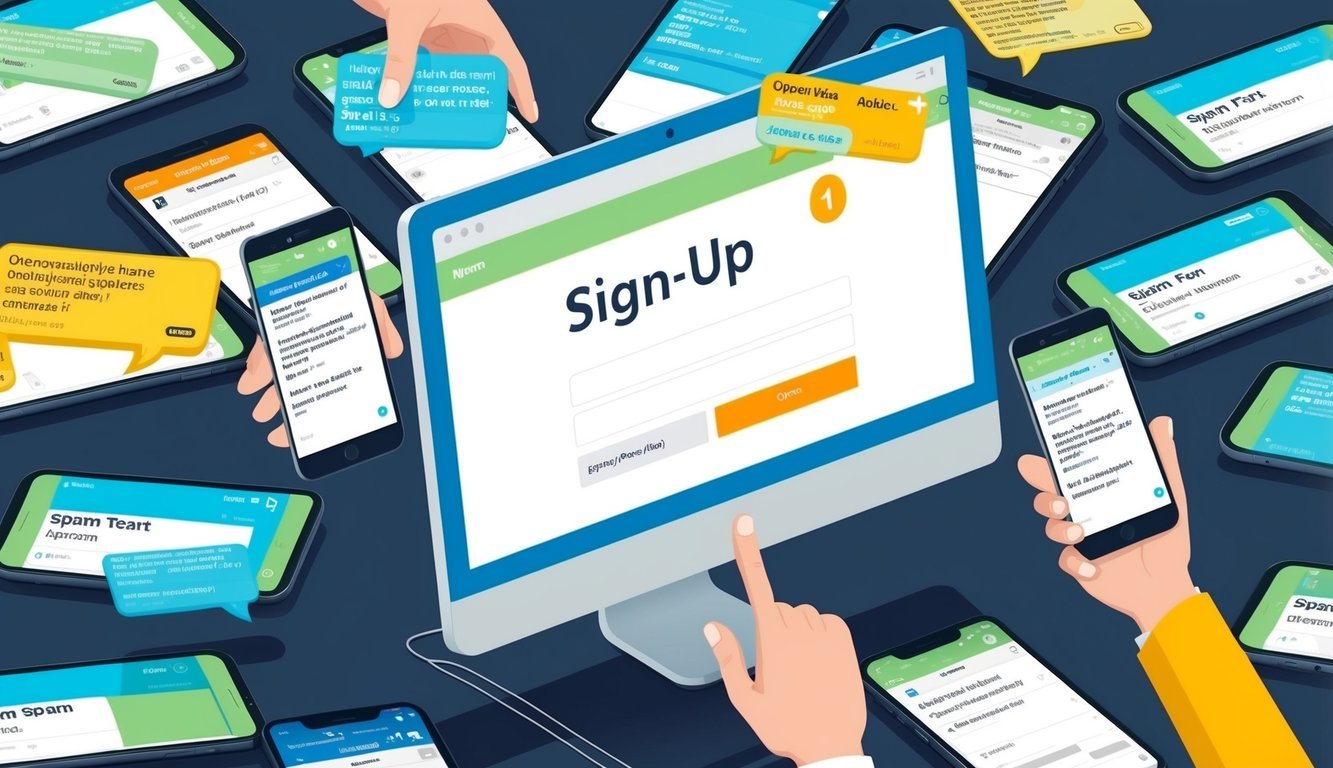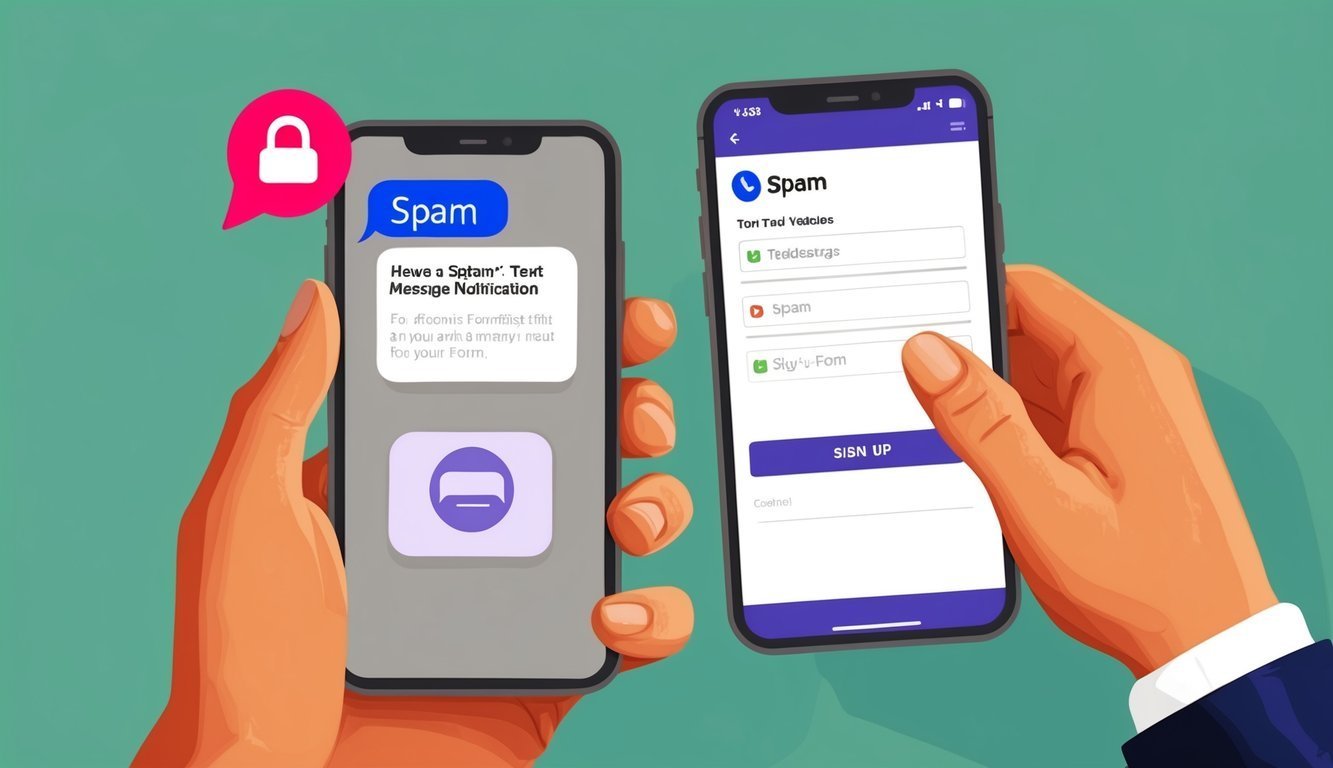Spam texts are the pesky weeds of our digital gardens—always popping up when we least want them.
They crowd our inboxes and can waste precious time.
But here’s a thought: what if you could flip the script? While there are tricks to sign someone up for spam texts, let’s pause and think about the ethics and potential fallout of playing that prank.
Some clever folks suggest using websites made for prank calls and texts, while others get creative by entering phone numbers into online forms or contests.
Sure, this approach might lead to an avalanche of unwanted messages for the target, but let’s be real; consent is key.
Before taking a step into the spammy waters, remember: signing someone up without their consent might land you in legal trouble in some places.
Besides, think about how it could sour relationships and trust.
Many websites are wise to these shenanigans and have measures in place to catch fraudulent sign-ups, which could backfire on you.
Plus, violating terms of service agreements could lead to account suspensions or legal headaches.
Bottom line: let’s respect each other’s privacy and aim for more ethical ways to deal with annoyances.
Key Takeaways
- Prank websites or online forms can be used to send spam texts.
- Signing someone up without their consent can result in legal and ethical consequences.
- There are better alternatives to handle conflicts or prank friends without being mean.
Understanding Spam Texts and Calls
Spam texts and calls have become a real headache for many of us.
They’re often hard to spot and even harder to stop.
Let’s break down what qualifies as spam, where it’s coming from, and how you can shield yourself from this digital nuisance.
What Counts as Spam
Spam typically includes unsolicited calls and texts trying to sell something or pull off a scam.
Here’s a quick rundown of what you might encounter:
- Robocalls delivering pre-recorded messages
- Live telemarketers pushing products
- Fake offers or prizes aimed at luring you in
- Phishing attempts trying to snatch your personal info
Most spam breaks rules like the Telephone Consumer Protection Act (TCPA) and ignores the National Do Not Call Registry.
How frustrating is that?
Common Sources of Spam
Spam can come from all sorts of places:
- Data breaches that spill phone numbers
- Public records and directories
- Social media profiles
- Entries in contests or sweepstakes
- Signing up for various services or websites
Some spammers use auto-dialers to call lots of numbers quickly, while others buy lists from shady sources.
It’s like having a lead foot in a bumper car ride—chaotic and unavoidable!
Protecting Yourself from Unwanted Contacts
You can take action to reduce spam:
- Join the Do Not Call list to reduce unsolicited calls.
- Use call-blocking apps to screen unwanted messages.
- Be cautious about sharing your phone number online.
- Don’t call back unknown numbers, especially 800 or 900 numbers.
- Report spam to your phone carriers or the FCC.
And remember, when it comes to texts asking for personal info, trusted companies won’t usually ask for that in a text.
If you’re ever in doubt, contact the company directly using a number you know is safe.
Taking Action Against Spam

Spam texts and calls can feel relentless, but don’t worry—there are easy ways to fight back.
Let’s look at how you can sign up for the Do Not Call list, use blocking tools, and report spam effectively.
Signing Up for the Do Not Call Registry
The Do Not Call Registry is a fantastic, free service that helps cut down on those annoying calls and texts.
Managed by the FTC and FCC, it’s simple to sign up—just visit donotcall.gov or call 1-888-382-1222.
It takes about a day for your number to join the list.
Just a heads-up, though—it won’t stop every spammy contact.
Certain groups, like charities and political campaigns, can still reach out, and let’s be honest, scammers usually disregard the list altogether!
Using Call-Blocking Solutions
There are some nifty call-blocking tools and apps out there.
Many phones come with built-in features to block spammy numbers.
Plus, you can download apps that screen calls and texts.
Here are a few popular blocking apps you might want to check out:
- Truecaller
- RoboKiller
- Hiya
These apps tap into vast databases of known spam numbers, catching junk before it hits your device.
The best part? You can often block numbers yourself too!
Reporting Spam and Understanding the Law
Reporting spam is crucial in catching those pesky spammers.
You can forward spam texts to 7726 (which spells SPAM!).
For calls, you can file complaints at ftc.gov/complaint.
Let’s not forget—it’s illegal to send commercial texts without permission, and robocalls to cell phones are no different.
Violators can face fines that can go up to $1,500 for each violation.
That’s some serious cash!
Always be cautious about signing up for things online.
Free trials and contests often lead right to spam hell.
Double-check the fine print before sharing your number, and never reply to texts asking for personal info—that’s usually a red flag.
Frequently Asked Questions

Spam texts can be a real pain and pose risks too.
Here are some key points to remember about signing someone up for spam texts and how to handle them.
What are the consequences of signing someone up for spam calls?
Signing someone up for spam calls can annoy the heck out of them.
They might end up flooded with unwanted messages at all hours.
Plus, if scammers get their hands on that phone number, it puts their personal info at risk.
Can you block numbers that have been signed up for spam?
Absolutely! Most phones let you block specific numbers, often right from your messaging app settings.
Many also feature spam filters to catch those shady texts before they even reach you.
What’s the deal with all these spam text sign-ups?
Spam texts are skyrocketing! Just check this out—back in March 2022, U.S. phones received a staggering 11.6 billion scam messages.
That’s a 30% increase from the previous month.
Scammers are getting creative!
Are there any legal repercussions for spamming someone’s phone?
You bet! Sending spam texts without consent is against the law in many areas.
Those who pull these stunts might face fines or other penalties.
Just remember, the specifics can vary by local laws.
How do you report spam texts to authorities?
Forward spam texts to 7726 (SPAM).
This helps phone companies block similar messages down the line.
You can also report spam right in most messaging apps.
Do any services compensate people for receiving spam texts?
Nope, legit services won’t pay you for receiving spam texts.
Be cautious of any claims to the contrary—they’re often just scams trying to snag your information.

